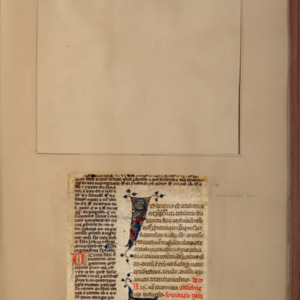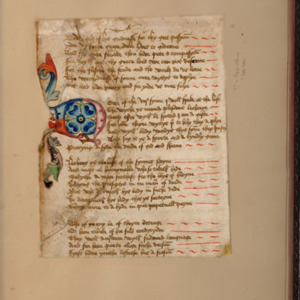Fragmenta Manuscripta Album
A Digital Reconstruction
What Was the Fragmenta Manuscripta Album?
Fragmenta Manuscripta is a collection of almost 300 different manuscripts and illuminations spanning from as early as the eighth century to as late as the fifteenth century. The collection itself came to Columbia in the 1960s in a large leather-bound book; there were pages and pages of different manuscripts displayed without descriptions or any indication of what each individual piece contained.
Through study, many pieces were identified at least in the century they were made, and sometimes the different purposes each individual page was used for. Fragmenta Manuscripta does not resemble a nineteenth century guardbook, which was made and produced to preserve manuscripts in the whole. Instead of whole manuscripts, Fragmenta Manuscripta has fewer than twenty pages from the same manuscript within its covers.
Fragmenta Manuscripta was mostly collected by a circle of men consisting of John Bagford, Thomas Tenison, Humfrey Wanley, and others. John Bagford receives a lot of credit for being able to collect the pieces preserved in Fragmenta Manuscripta within the book trade by slipping pieces of manuscript from books he collected and sold. He pulled the manuscripts from the binding of the books he traded, which is why most of the pages have dark patches across some length of the page. The materials to make manuscripts were costly, and instead of tossing beautiful works that had multiple different purposes, they were reused as an agent in bookbinding for the front and back boards of new books.
Fragmenta Manuscripta is half of another collection held in Cambridge University. This collection is called Fragmenta Varia and is a much larger collection. Some five-hundred different pieces of manuscripts are preserved in Varia that are dated between the fifteenth to seventeenth centuries. If one just takes a glance at the collection, along with the sister book Fragmenta Varia housed in Cambridge, they will assume that the collection was made to preserve historical documents. This was not the case for Manuscripta or Varia; these collections look more like a collection of antiquarian curiosities than a need to preserve history and need to fuel the interest of printing and book making that John Bagford had.
These two collections are, in large, the initial collection of John Bagford’s interests and hobby in life. The collection has had additions apart from Bagford’s initial findings which were added by later owners. Although the collection does not contain a complete manuscript, the pages that were preserved create a window into the artistic value manuscripts provided society in the Middle Ages before they were repurposed.
Digital Reconstructions

Fragmenta Manuscripta 064, titled Antiphonal. Dated around 1150-1175, possibly from France. Antiphonals are sentences recited by singing in two parts. There is red rubrication on the page, but otherwise most of the page is taken up by musical notes and not Latin text.

Fragmenta Manuscripta 096, tilted Canon Law with Gloss. Dated around 1290-1310, from Southern France. Canon law refers to rules and regulations made by an ecclesiastical authority. It is law for a Christian church and its members. It shows beautiful rubrication and an animal depicted with a human head.

Fragmenta Manuscripta 097, titled Calendar November, December. Dated around 1300-1399, from Ireland. The page shows a calendar of the months November and December, though the lettering is dark and hard to read. Recto, the front of the page, is the December calendar, Verso, the back of the page November.

Page 101 of Fragmenta Manuscripta, titled Digest. Dated around 1300-1315, from Italy. This page highlights legal or secular work. This is a page depicts three men standing before a judge. They are in a dispute over property boundaries. It is made on parchment and cropped awkwardly.

Fragmenta Manuscripta 177, titled Instructions to His Son, created by Peter Idley. Dated around 1490-1510, from England. This fragment displays a letter from Peter Idley to his son, the language reading in English compared to the common Latin everywhere else. There is also a large decoration in the letter.
About the Project
By Andrew Schulte
While working on Fragmenta Manuscripta, I sorted through and handled all the fragments to study and understand the material I was going to be researching and writing about. After working with the fragments, I was able to learn and use the Mark II in Digital Initiatives to scan the physical album. Learning how to use the cameras and operate the Mark II was educational and exciting; I was also able to learn the way digital collections create their logs for projects and work with creating the images for Fragmenta Manuscripta. I was also taught how to use Photoshop and was able to recreate a digital version of certain pages within the collection as if they were never removed from the album.
More importantly, aside from personal skills that I was able to learn and develop, I was able to participate in producing public history among the University. I was able to replicate and publish a few images of the original album so that others may be able to see that what Fragmenta Manuscripta looked like before the page were cut out for better preservation. It allows for a digital recreation of the original album to exist again and be published; a piece of history from a few centuries ago to live and be shared in modernity.
Works Cited
GATCH, MILTON McC. “JOHN BAGFORD, BOOKSELLER AND ANTIQUARY.” The British Library Journal 12, no. 2 (1986): 150–71. http://www.jstor.org/stable/42554242.
McC. GATCH, MILTON. “‘FRAGMENTA MANUSCRIPTA AND VARIA’ AT MISSOURI AND CAMBRIDGE.” Transactions of the Cambridge Bibliographical Society 9, no. 5 (1990): 434–75. http://www.jstor.org/stable/41154792.